- Introduction to Kuchipudi, the classical dance style of Andhra Pradesh. Article also covers the origin, evolution and technique of this dance form over time.
Kuchipudi,
the classical dance style of Andhra Pradesh, is accepted as a solo dance style
that has evolved from the dance drama tradition of Bhagavata Mela Natakam. Stories of Hindu tradition, particularly Vishnu Sampradaya (Vishnu worship), are interpreted through the medium of stylized and rhythmic movements, typical “hasta mudras” (hand gestures), and expressional dancing. Kuchipudi pays equal emphasis to elegance and vibrant movements. It is performed by both men and women.
Also read Significance
of and About Hasta-mudras
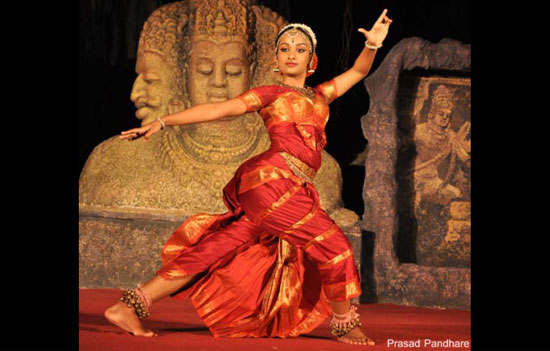 Yamini Reddy performing at Elephanta Festival 2011.
Yamini Reddy performing at Elephanta Festival 2011.
Evolution and history
The word
Kuchipudi comes from the village Kuchelapuram in Krishna district in Andhra
Pradesh. The Sanskrit word Kusilava-puram refers to the
village of actors, travelling bards or dancers. The authoritative text on dance
and dramaturgy Natya Sastra, written
by Bharata Muni, with 6,000 verses in 36 chapters, evolved during 500 BCE to
500 CE. It mentions the graceful movements known as Kaisiki Vritti. The 1st millennium Sanskrit text by
Bruna Nettle credits its origin to the second century. However, a pre-second
century text calls one raga (musical melody), as Andhri (Andhra),
related to Gandhari Arshabi. Thereby,
Kuchipudi evolved from the 2nd century itself.
Also read What is
a Raga
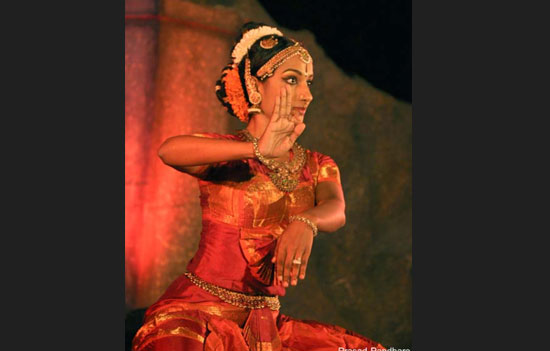 Yamini R. Shivas bhavabhinaya means expressions.
Yamini R. Shivas bhavabhinaya means expressions.
The
ancient dance form of Kuchipudi finds its place in the 10th century copper
inscriptions and in the 15th century texts like Machupalli Kaifat. They refer to Kuchipudi dance. According to
Manohar Varadpande, Kuchipudi emerged during the late 13th century and the
reign of Ganga rulers of Kalinga. The dancers also enjoyed royal patronage
during the reign of King Krishnadevaraya of the Vijayanagara Empire.
R
C Mazumdar wrote
in the foreword of Vol 6 of the History and Culture of Indian People that the rise of Independent States (1300 to 1526) meant more courts and thereby the centres of patronage.”
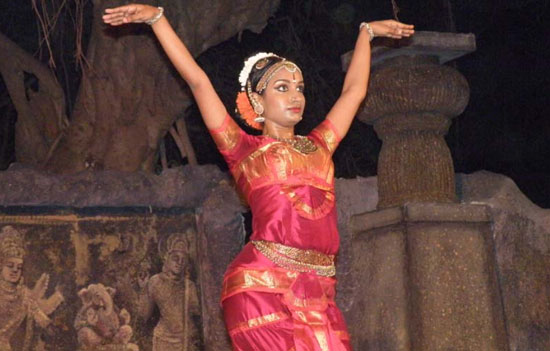 Argalam Karana – Yamini Reddy.
Argalam Karana – Yamini Reddy.
In
1678, the last Shia Muslim Sultan of Golkonda, Abul Hasan Qutub Shah, gifted
the Kuchipudi village o the dancers, as he was quite impressed with their
brilliant performance. However, Aurangzeb was completely against arts and
artists. The British too, did not approve of classical dancers and performing
arts suffered a setback.
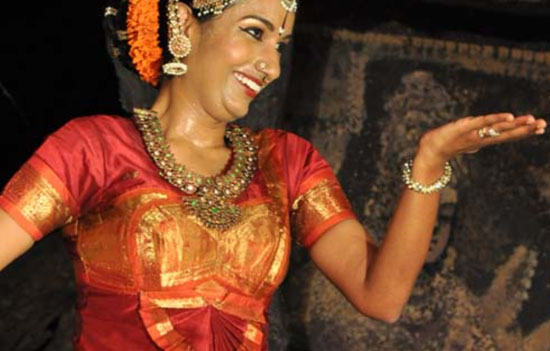 Haasayam or Laughter/ridicule-Yamini R.
Haasayam or Laughter/ridicule-Yamini R.
Pioneer mentors and technique
The
foremost pioneer mentors were Vedantam Lakshiminarayana Sastri (1886- 1956),
Vempatti Venkataramayya Sastri and Chinta Venaktaramayya Sastri.
Prior
to the Bhagavata Nataka tradition, dancers interpreted stories related to
Shaivism that were known as Brahmana
Melas. According to the tradition Nattuva
Melas related to the invocatory Puja dance, Kalika dance in the Kalyana
mandapa, Natya Mela pertained to
ritual dances, Kalika dance for
intellectuals and Bhagavatam for
commoners in order to reach out to a larger section of people, as classical
dance was not understood by the common man.
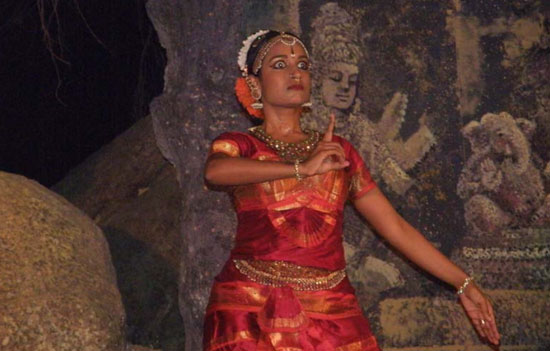 Raudram or anger-Yamini R.
Raudram or anger-Yamini R.
Teertha
Narayana Yati, who wrote the Krishna
Leela Tarangini, was a sanyasin (sage) of Advaita Vedanta. He and his
disciple Siddhendra Yogi founded the systematised version of Kuchipudi dance in
the 17th century and wrote Bhama
Kalapam (story of Satyabhama), He promoted Kuchipudi, encouraged and motivated
Brahmin boys to take up Kuchipudi dancing. Why not women? Then it was felt that if females danced, the
purity of dance would be destroyed. This indeed was a major step, pertaining to
the development of Kuchipudi dance.
Vempatti
Chinna Satyam further refurbished the dance style and placed it on the
international map. The technique is similar to Bharata Natyam but unlike
Bharata natyam Kuchipudi dancers are quite light-footed and the speed changes
in split seconds. The spring like movements, like a bouncing ball, make the
presentation quite different and with a folkish touch.
Kuchipudi
is quite complex and the rhythmic patterns of footwork and movements change
rapidly and abruptly. Hence, unless the dancer has a fine command of rhythm (tala), he or she will not be able to
perform precisely which is the hallmark of Kuchipudi dancing.
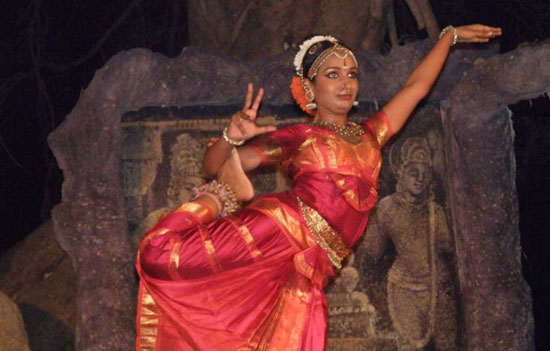 Latavrscika Karana-Yamini Reddy.
Latavrscika Karana-Yamini Reddy.
Unlike
Bharata Natyam that follows different geometrical patterns with sharp and
vibrant movements, Kuchipudi differs with the style of presentation which is
light-footed and many times the dancer is moving on her toes and stamps on the
feet after completing a particular sequence of movement and not otherwise. The
dancer dances, after the completion of a particular verse or sahitya, as equal emphasis is paid to
expressional dancing, as the story-telling aspect
of dance is consistent, along with varied simultaneous movements of the hands
and legs.
Thus,
fine training is essential which starts at a tender age, as it is not easy to maintain
the harmony and synchronization of dance with music and the exposition of
various gestures, gesticulations and abhinaya
in particular. It takes several years of consistent practice or riyaaz to reach a certain level of
proficiency or mastery over the art form.
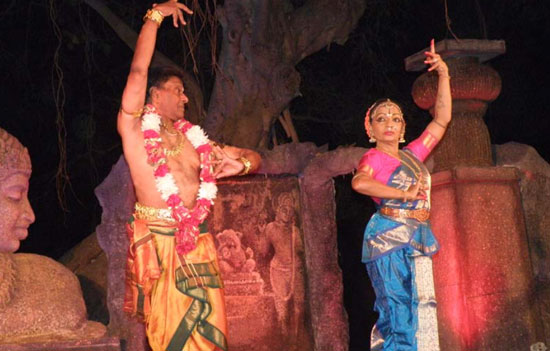 Raja and Radha Reddy performing the Raasa-Vilaas of Lord Krishna.
Raja and Radha Reddy performing the Raasa-Vilaas of Lord Krishna.
Performance
and music
Bhama Kalapam (story of royal
lady Satyabhama), written by Siddhendra Yogi, is considered the mainstay of the
Kuchipudi repertoire. Besides Golla
Kalapam, written by Ramiah Sastri, is an ethical satire between Gopis and
Brahmins. Kritis of Tyagaraja and Padams of Kstreyya etc, are also part of the
performance. Music is in Carnatic style although sometimes Hindustani ragas are
also used
American
Esther Sharman, renamed as Ragini Devi, whose daughter Indrani Bajpai or
Indrani Rehman and Yamini Krishnamurthi are among the foremost exponents.
Leading exponents are Raja, Radha and Kaushalya Reddy (my mentors), Swapna
Sundari, Shoba Naidu, Vyjayanti Kashi, Jayarama Rao and Vanashree Rao, Padmaja
Reddy, Vempatti Srimoyi, Bala Tripurasundari, Deepika Reddy, Narasimha Chari,
Anuradha J, Vanaja Lal, Alekhya Punjala and young dancers like Yamini and
Bhavana Reddy, Parateeksha Kashi, Avijit Das, Amarnath Ghosh etc.
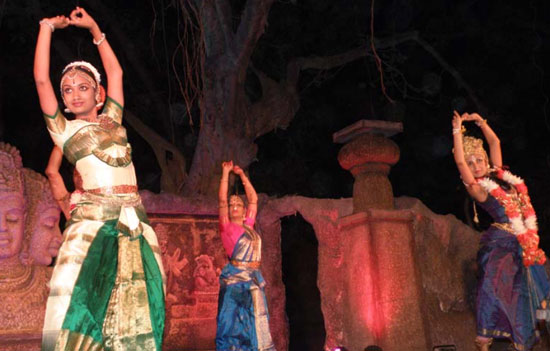 Raja, Radha, Yamini, Bhavana Reddy performing the Tarangam, dancing on the rim of brass plate. When the dancer dances on the rim of brass plate all earthly connections are broken & prayers reach Ishwara directly.
Raja, Radha, Yamini, Bhavana Reddy performing the Tarangam, dancing on the rim of brass plate. When the dancer dances on the rim of brass plate all earthly connections are broken & prayers reach Ishwara directly.
Traditionally,
a Kuchipudi performance commences with invocations to the trinity, Brahma, Vishnu
and Maheswara, a shloka in praise of Ganesha and the goddess. The dancer seeks
blessings and divine intervention for the success of the performance, without
any hindrance whatsoever. The Jatiswaram
marks the fine combination of music, melody and rhythm, interwoven with
stylized and intricate rhythmic patterns. Hence, the dance needs to be
completely prepared for. Other items of the repertoire includes, the padam sabdam varnam, bhajan, finally the
Thillana and the Tarangam which is considered the highlight of the performance, as
the dancer dances on the rim of the brass plate, executing complex and rhythmic
patterns with precision
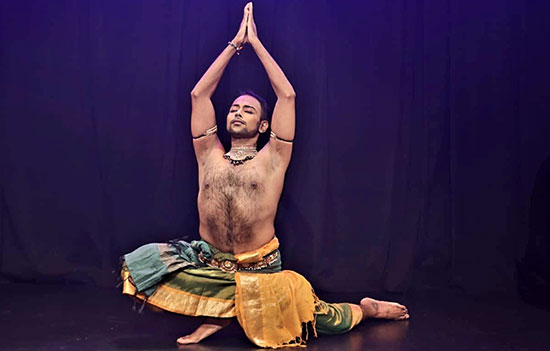 Amarnath Ghosh.
Amarnath Ghosh.
Performances
are normally solo but lot of dance dramas are presented like Rukmini Kalyanam,
Sreenivasa Kalyanam, Dashavataram, Ramayana or stories pertaining to Lord
Shiva, Ganesha and Shakti.
It is believed that if you have to please Lord Krishna, you have to appear in the “female aharya” at least once in your lifetime. During the early 19th century females were barred from performing Kuchipudi as it was believed that if females perform, the chastity of the dance form will be destroyed. Hence Siddhendra Yogi pledged and induced Brahmins to take to Kuchipudi dancing. Times have changed now.
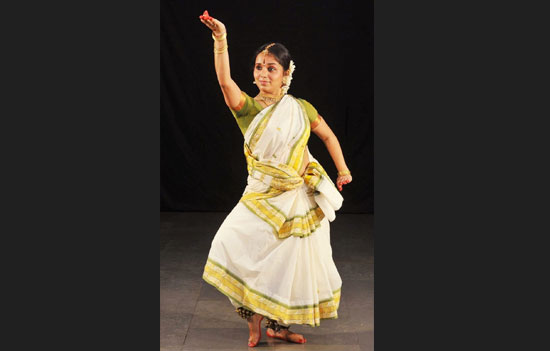 Vempatti Srimayi.
Vempatti Srimayi.
One
of the mainstays of the Kuchipudi repertoire is enaction of the story of
Satyabhama in Bhama Kalapam. The interesting story that unfolds is, Krishna wanted to teach Satybhama a lesson as she was proud and arrogant and considered herself to the most beautiful woman in the world. In the encounter with Satyabhama Krishna asks her, who is more beautiful “You or me”, Krishna knew the answer, as expected Satyabhama considered herself to be more beautiful than Krishna. Also, Krishna argued with her and abruptly drifted away, so that she would realise her folly of being ahankaari (egoistic). Later Satyabhama realised her mistake and repented.
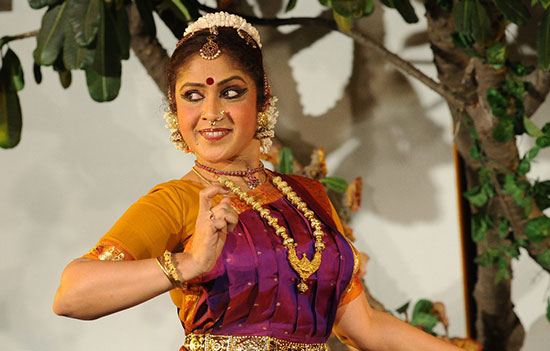 Dr Ananda Shankar Jayant.
Dr Ananda Shankar Jayant.
Lastly,
I narrate an interesting incident in the life of the renowned Kuchipudi
exponent, Dr Yamini Krishnamurti. While dancing to the popular number Swami Ra Ra (My Lord, please come), she
was addressing the audience with her beautiful netra abhinaya. A Sardarji from the audience felt that he was being called to the stage so he went up to meet her. Yamini retorted, “I am calling My Swami. My Lord. You Are not My Swami.”
 Avijit Das.
Avijit Das.
Guru Vijay Shanker is a professional Kuchipudi, Kathakali
exponent, dance teacher, choreographer, actor and arts critic for over four
decades, contributing for national and international publications. He is
particularly credited for his lecture-demonstrations on Indian classical
dancing which is a fine combination of both education and entertainment.
To read all
articles by author